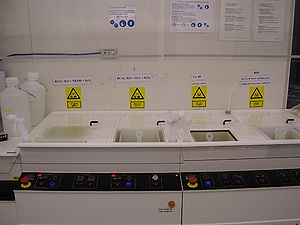Specific Process Knowledge/Wafer cleaning/RCA
Feedback to this page: click here
Unless anything else is stated, everything on this page, text and pictures are made by DTU Nanolab.
All links to Kemibrug (SDS) and Labmanager Including APV requires login.
All measurements on this page has been made by Nanolab staff.
RCA cleaning
The RCA cleaning procedure was originally developed by the Radio Corporation of America (RCA) as part of manufacturing electron tube components. This process has since been adapted to silicon semiconductor processing. RCA is a two-step process (RCA1 and RCA2, sometimes referred to as SC-1 and SC-2 (Standard Clean)), and RCA1 should always be made before RCA2 because removing organic contaminants is a requirement before metal contaminants can be removed effectively.
RCA1 is a powerful oxidizer and will thus remove organic contaminants. The ammonium hydroxide in RCA1 also has good solvating power as it can complex metals such as Cu, Ag, Ni, Co and Cd into solution. RCA2 forms soluble complexes with heavy metals and also shows cleaning action similar to that of piranha solutions. Furthermore, solutions of hydrochloric acid, which is a major constituent of RCA2, has proven effective at removing alkali metal ions. RCA2 is also effective at removing metal hydroxide traces that cannot be removed in ammonia-containing solutions such as RCA1. These include Al(OH)3, Fe(OH)3, Mg(OH)2 and Zn(OH)2. It is important that the chemicals used are very clean. RCA mixtures are therefore only used shortly after mixing and for a limited number of samples.
Since RCA1 can oxidize silicon to silicon dioxide, an HF dip is sometimes used between RCA1 and RCA2. This will also remove contaminants that can be trapped in the formed oxide. However, this step is often omitted, since RCA1 removes the native oxide and then re-oxidizes the surface. This in itself has a cleaning action. It is generally not advised to do an HF dip after RCA-2 if the samples will be processed by wet chemical processes afterwards. This is because the hydrogenated surface will be extremely reactive and therefore attract contaminants from both the air and processing liquids. In this case it is better to continue processing with the passivated oxide surface. RCA clean is often done prior to furnace processes, an in these cases an HF dip after RCA-2 makes sense. Ideally the wafers should be transferred to the furnace immediately after RCA cleaning, because the samples will be very sensitive to recontamination as mentioned above.
A crucial part of the RCA cleaning procedure is the oxidation by H2O2 at elevated temperatures. Therefore, the lifetime of RCA1 and RCA2 solutions is limited to about 1 hour after preparation and heating to 70oC because H2O2 decomposes at this temperature. A temperature of 70°C is optimal. RCA solutions should never be heated above 80°C since this will lead to excessive decomposition and loss of NH3.
- RCA1 contains: H2O, NH4OH and H2O2 (5:1:1). It is used for removal of light organics, particles and metals.
- RCA2 contains: H2O, HCl and H2O2 (5:1:1). It is used for removal of heavy metals, metal hydroxides, and residual metals including alkali metals.
You can find the APV for the RCA bench here
RCA procedure
- RCA1: 10 min
- DI water rinsing (dumping three times)
- Optional: HF: 30 sec (you may avoid this step in case of a very thin oxide (0-200 Å) as the top layer)
- DI water rinsing (bubbler)
- RCA2: 10 min
- DI water rinsing (dumping three times)
- Optional: HF: 30 sec (avoid it if you have a very thin oxide (0-200 Å) as the top layer)
- DI water rinsing (bubbler)
For procedure details please look in the user manual in LabManager.
The user manual, user APV and contact information can be found in LabManager: RCA info page in LabManager
Overview of RCA process data
| RCA1 (SC-1) | RCA2 (SC-2) | HF | |
|---|---|---|---|
| General description |
Used for removal of light organics, particles and desorption of trace metals (Au, Ag, Ni, Cd, Zn, Co, Cr, etc). |
Used for removal of alkali ions, metal hydroxides (of Al, Fe, Mg, Zn) and residual trace metals (e.g. Cu and Au). |
Used for removal of oxide generated in RCA1 and RCA2 |
| Chemical solution | H2O, NH4OH(25-29%) and H2O2(30%) (5:1:1) | H2O, HCl(37%) and H2O2(30%) (5:1:1) | 5% HF |
| Process temperature | 70-80 oC | 70-80 oC | Room temperature |
| Process time |
10 min. |
10 min. |
30 sec. |
| Life time of the chemical solutions | Can only be heated one time. When hot: it lasts for ~1h | Can only be heated one time. When hot: it lasts for ~1h | ~2 months |
| Allowed materials |
|
|
|
| Batch size |
1-25 2",4" or 6" wafers at a time |
1-25 2",4" or 6" wafers at a time |
1-25 2",4" or 6" wafers at a time |
| Size of substrate |
4"-6" wafers |
4"-6" wafers |
4"-6" wafers |
